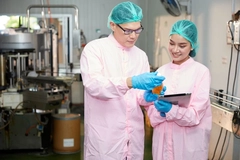FlyFeed CEO: “Insect protein production contributes to the circular economy”

26 Jan 2023 --- Current agricultural systems are failing to feed the global population sustainably. According to FlyFeed, an international insect farming start-up from Estonia, this problem will deepen with the growing demand for protein worldwide. The company’s long-term goal is to make the black soldier fly (BSF)-based protein meal three times cheaper than chicken meat by 2027.
Black soldier fly larvae (BSFL) play a role similar to that of redworms as essential decomposers in breaking down organic substrates and returning nutrients to the soil. The larvae have voracious appetites and can be used for composting household food scraps and agricultural waste products. Additionally, BSFL are an alternative source of protein for aquaculture, animal feed, pet food and human nutrition.
FoodIngredientsFirst speaks with FlyFeed’s founder and CEO, Arseniy Olkhovskiy, who says the demand for insect products is “already way higher than the available supply.”
“In 2022, there were 3 billion people who could not afford healthy nutrition, and 1 billion people were undernourished or did not get enough calories,” he explains.
As the global population is rapidly growing, Olkhovskiy believes that innovative solutions should be quickly introduced to tackle the problem of malnutrition.
“Governments are trying to solve the issues of malnutrition problems on a national level, but they face restrictions and make decisions slowly due to substantial oversight,” he explains.
There have been a string of recent developments in the insect protein sectors. Last October, the International Platform of Insects for Food and Feed welcomed the European Union Member States authorities’ green light to the draft implementing regulations from the European Commission, aiming to authorize the commercialization of frozen and freeze-dried formulations of the lesser mealworm (Alphitobius diaperinus) and partially-defatted house cricket (Acheta domesticus).
 Olkhovskiy believes that innovative solutions should be quickly introduced to tackle the problem of malnutrition.Earlier this month, Singapore-based start-up Protenga also discussed how it is using BSF and the potential insect protein as feed, pet food, fertilizer, and possibly beyond, going into the food arena.
Olkhovskiy believes that innovative solutions should be quickly introduced to tackle the problem of malnutrition.Earlier this month, Singapore-based start-up Protenga also discussed how it is using BSF and the potential insect protein as feed, pet food, fertilizer, and possibly beyond, going into the food arena.
Meanwhile, following Brexit the sector has been in limbo regarding the legal status of edible insects in the UK with Woven, the UK network for insects as food and feed advocating that insects are safe to eat and could be part of a future shift which will see increasing numbers of ento-vegetarians worldwide.
Technologies and new methods boost offerings
Start-ups are able to iterate quickly to implement novel technologies, Olkhovskiy underscores.
“The lack of bureaucratic restriction allows entrepreneurs to develop and refine ideas through innovative methods. By employing these methods, we can scale production more effectively. This makes businesses more lucrative, develops the global market, and contributes to solving global problems faster and more effectively.”
That’s why FlyFeed considers other insect protein producers as cooperating partners rather than competitors. The company also shares the same commitment to developing sustainable protein production, Olkhovskiy tells us.
“All insect farms can be scaled vertically, producing a hundred times more protein per square meter than soybean or animal farming. Secondly, insect protein production contributes to the circular economy by transforming food waste into healthy proteins and fats worldwide.”
Protein boost
Insect protein can be incorporated into a range of dishes, from appetizers and snacks to full original meals. “It can provide a high-quality source of animal protein as well as essential fatty acids and vitamins, making it an excellent addition to any diet,” Olkhovskiy continues.
Insects can be cooked, ground into powder, or processed into flour and used in various recipes, ranging from tortillas to energy bars. Additionally, insect protein is a great way to add a unique flavor to traditional dishes, like soups, salads and entrees.
Of course, insect protein production uses much less water, land, and energy than any livestock-derived protein. Therefore, it serves as a high-quality and low-cost ingredient to increase the productivity of the food industry and human food chain in general due to the circularity of production and its incredible flexibility as part of a nutritious diet.
FlyFeed produces insect protein from the black soldier fly. They are exceptionally rich in protein and fat, and their bioconversion is very efficient.
“The potential option for both pets and humans is to eat whole dried larvae – this is a wonderful healthy snack, which is already popular in Vietnam.”
Larvae development
As of July, 1, 2017, EU Regulation 2017/893 came into force which means that legally the following species are approved for aquafeed: BSF (Hermetia illucens), Common Housefly (Musca domestica), Yellow Mealworm (Tenebrio molitor), Lesser Mealworm (Alphitobius diaperinus), House cricket (Acheta domesticus), Banded cricket (Gryllodes sigillatus) and Field Cricket (Gryllus assimilis).
According to Olkhovskiy, 2023 will be “a groundbreaking year” for FlyFeed, because it will finish the construction of its first insect factory in southern Vietnam.
“It will be equipped with leading tech solutions like data-driven climate control and computer vision to analyze larvae development. The production capacity is 17,500 metric tons of insect products per year, which will be achieved by processing 40,000 metric tons of local agricultural waste,” he comments.
FlyFeed has signed over US$10 million in pre-contracts to sell protein and fat components worldwide, including the European pet food and aquaculture feed markets.
Also, the Vietnamese government is very supportive of FlyFeed and insect farming as a whole, and it is willing to develop a legal infrastructure for such a novel industry, he details.  FlyFeed is an international insect farming start-up aiming to reduce global malnutrition by producing the cheapest animal protein in the world.
FlyFeed is an international insect farming start-up aiming to reduce global malnutrition by producing the cheapest animal protein in the world.
“We have developed a unique substrate preparation approach to rear the BSF on seasonal agricultural leftovers the whole year round. This is vital for enhancing the consistent circular economy. The electric energy necessary to operate the production comes mainly from hydropower plants nearby and our own solar panels,” explains Olkhovskiy.
BSF larvae are extremely rich in protein and fat, so during the processing, the main focus is to separate the oil from the rest of the meal. Olkhovskiy says it’s no secret that the technologies for this purpose are well-developed in the meat and fish processing industries.
“The tricky part is applying them correctly to our tiny species and at the same time reaching the product specifications our customers require.”
There are two main approaches to processing insects: dry and wet rendering. According to Olkhovskiy, each of them has its pros and cons depending on the regulations, the size of the production, and clients’ needs. “For the first factory, we committed to implementing a wet rendering process because we aim to produce a protein of higher-end quality.”
Diversifying the future
Olkhovskiy sees the globalization of insect farming as the main direction the industry continues to follow in the next few years.
“This includes spreading insect-based meals worldwide by adapting to local habits. The trend we experience right now is the geographical diversification of production: industrial insect farming has emerged in the US and EU, but now more and more companies are successfully launching production in South Africa, Malaysia, South Korea and Brazil,” he details.
“We are pleased to be a part of this developing industry aimed at keeping our planet livable for future generations and bringing essential products as well as new technologies and working opportunities to local communities around the globe. Our ambition beyond the first factory in Vietnam is to expand to the nearby regions with established demand for insect food to feed the world better,” he concludes.
By Elizabeth Green












